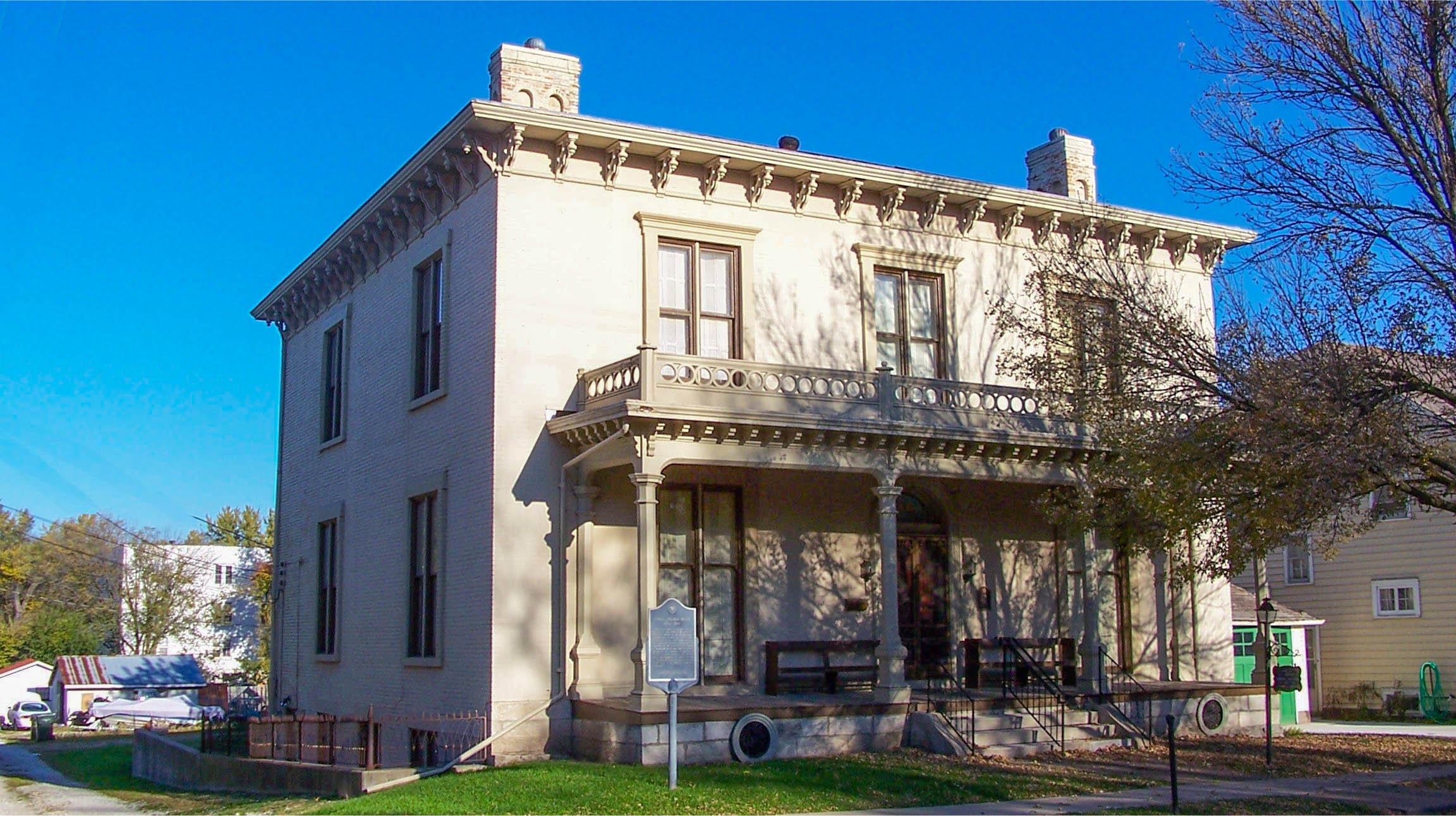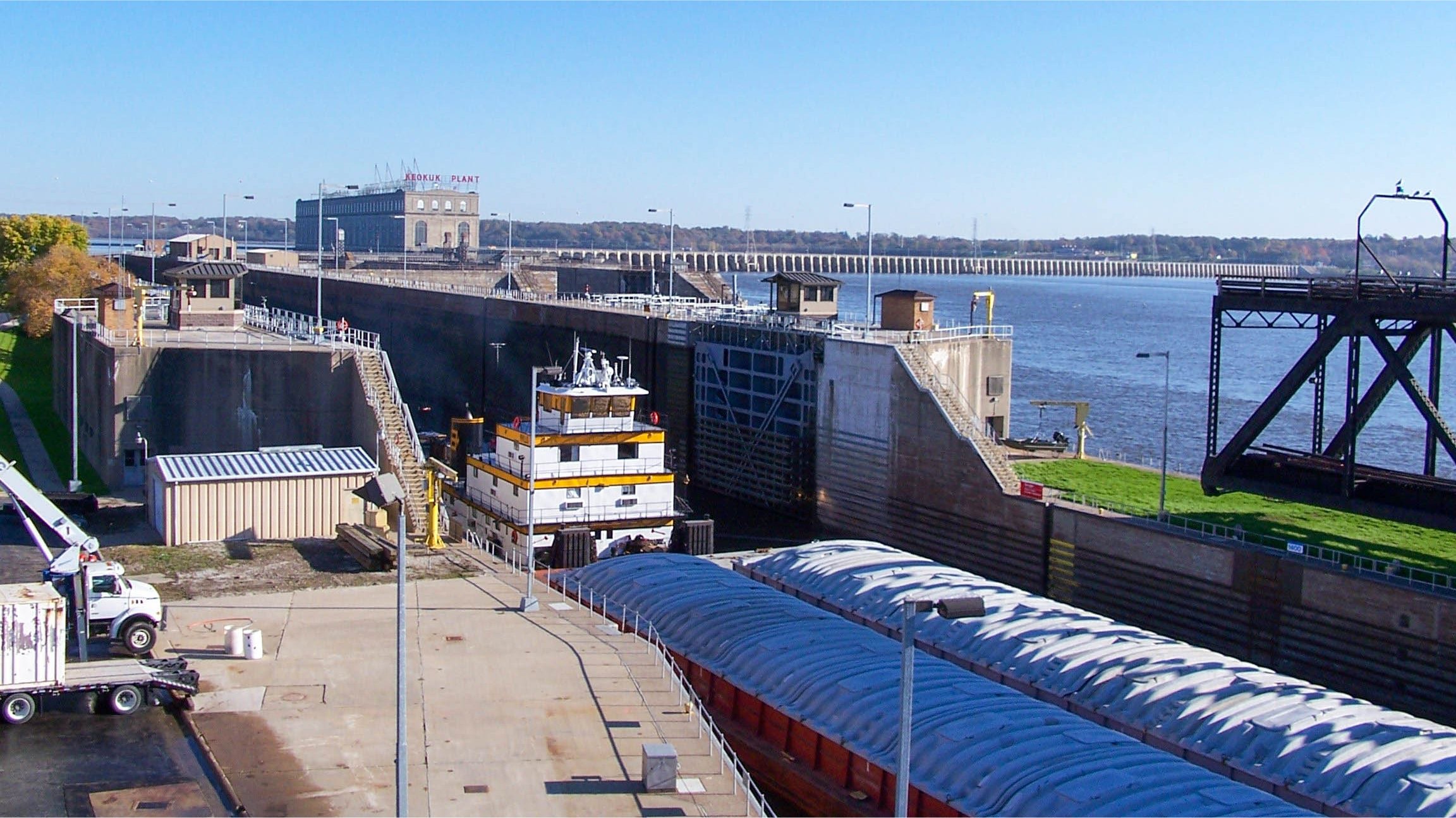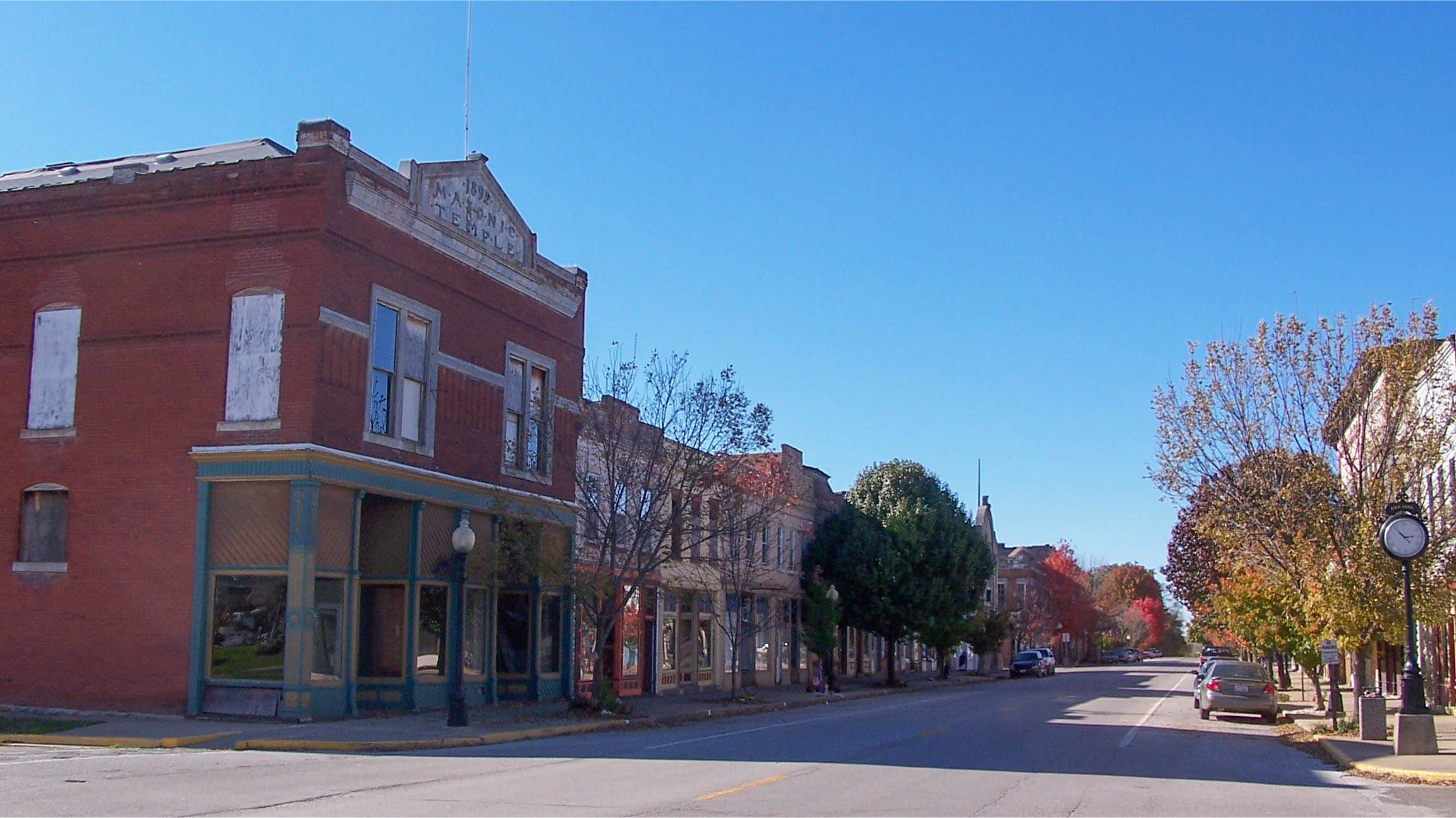Visitors Guide to Keokuk
Lee County, Iowa
The view from Rand Park overlooking the Mississippi River
Keokuk National Cemetery
In August 1805 Lt. Zebulon Pike was sent on a mission similar to the one given Lewis and Clark – to explore the Mississippi River, look for its source, record his observations, purchase sites from the Native American for future military posts, and to bring a few important chiefs back to St. Louis for talks. Just above the mouth of the Des Moines River, at the present Iowa/Missouri border Pike and his party got stranded on what are now called the Des Moines Rapids. These rapids were 12 miles long and according to records at the time had an average depth of less than 3 feet. The rapids were the first major obstacle to river traffic on the Upper Mississippi River. The spot that Pike labeled as the bottom of the rapids and where he made his ninth encampment became the site of the town of Keokuk.
The first white settler in Keokuk was Dr. Samuel Muir, a physician at nearby Fort Edwards who left the military after there were objections to his Sauk wife. Muir built a cabin at the foot of the rapids in 1820 and became a fur trader. There is some evidence that the site was originally called "Stilwell's Landing." 1820 was also the year that the steamboat era began on the Upper Mississippi when the Western Engineer arrived at the Des Moines Rapids. Riverboats became the basis for Keokuk’s early growth and the village provided wood for the steamboats. A small fleet of keelboats were used at Keokuk and Warsaw, located across the river in Illinois. These keelboats were used for “lightering,” where goods and passengers were transferred from the steamboats to these smaller boats for passage over the rapids.
In 1824 a treaty was signed with the Sauk and Fox tribes and William Clark, who represented the United States as Superintendent of Indian Affairs. In addition to the Sac and Fox ceding all their claims in northern Missouri, the treaty also established the Half-Breed Tract. This tract of 119,000 acres in the southeast corner the state of Iowa was intended to provide land for the children of white men and Native American women. One of the Sauk leaders who helped negotiate that treaty was Kiyo' kaga, (one who moves about alert,) later to become known as Chief Keokuk. Keokuk was a controversial figure noted for his policy of cooperation with the Americans. He led his people to Kansas in 1845 where he died three years later. In 1829 the American Fur Company established a trading post at Keokuk and the trading post, along with five adjoining cabins, became known locally as “Rat Row.” It is unclear why the city was named after Keokuk, a man who barely if ever spent any of his life in the town. It is said the name was first proposed by Col. George Davenport, an early settler to the area and namesake to the city of Davenport, IA, at a July 4th celebration aboard a steamboat in 1829. The official naming took place in 1834 when a saloon keeper named John Gaines placed a bottle of whiskey on his bar and at his suggestion, all those present who wanted to name the settlement "Keokuk" were to step up to the bar and have a drink. The vote carried 8 to 1. The town at the time contained one frame house and ten log cabins. Keokuk was officially platted in 1837.
The Miller House Museum
The next two decades brought a steady increase in steamboat traffic and with it many shipping and lightering jobs. Although Keokuk was growing, its fur traders and river laborers gave it a reputation as a rough place. The land around the town, the Half-Breed Tract, failed to attract any legal settlers due to ownership disputes between the half-breeds and land speculators. The issue of legal ownership was settled by the U.S. Supreme Court in 1850. By 1860 the small fur trading village had grown into a thriving commercial town and acquired the nickname as the “Gate City” because it was the entrance into the state of Iowa. The famous Rat Row, regarded by then as an eyesore, was destroyed by fire in 1849. With its population increasing from 2,512 in 1850 to 8,136 in 1860, Keokuk was increasing in importance and vying with Burlington for regional dominance. In 1850 Dr. David L. McGugin moved the College of Physicians and Surgeons from Davenport to Keokuk. The institution trained over three thousand medical students in Keokuk until it merged with the University of Iowa in 1908. Aside from Mark Twain, who lived in Keokuk briefly in the mid-1850s as a young man, the most well known figure of Keokuk’s steamboat era was Samuel F. Miller (1816-1890.) Miller was a U. S. Supreme Court Justice from 1862 until his death. Because of his anti-slavery sentiments, Miller left his home state of Kentucky in 1850, settling in Keokuk, where he practiced law and speculated in real estate and railroads. His home at 318 N. Fifth Street is now the Miller House Museum, operated by the Lee County Historical Society.
Keokuk was a major military center during the Civil War. Most of the regiments from Iowa regiments and some from states to the north were organized at Keokuk and then shipped off to the fighting by steamboat. Because of its medical college, Keokuk also became a center for the wounded and eventually had five military hospitals. In 1862 Keokuk donated land from the Oakland Cemetery for the Keokuk National Cemetery, the first designated national cemetery west of the Mississippi River. By the end of the war, the cemetery had interred over 600 Union soldiers and 8 Confederate prisoners of war and is currently the final resting place for over 4,600 American soldiers from all conflicts.
In 1866, Congress authorized the improvement of the rapids at Keokuk and Rock Island. Pressure by Keokuk city leaders resulted in a design for a 7.6 mile canal that would run along the Mississippi shore from Keokuk to Nashville, IA. In 1867 construction on the canal began that resulted in a section of the river being cut off by an embankment and water levels manipulated by three locks providing a 6 foot deep channel. On August 27, 1877 businesses closed and schoolchildren were excused from class and people lined the bluffs to see the first two riverboats, the snagboat Montana and the steamer Northwestern, pass through the completed canal. Over 5,000 people attended the ceremony that opened the Upper Mississippi River to unrestricted navigation.
The George M. Verity Museum in Victory Park
During the late nineteenth and early twentieth centuries in Keokuk, often called the canal era, the only other notable construction project was a railroad bridge. The bridge was built by Andrew Carnegie’s Keystone Bridge Company for the Keokuk and Hamilton Mississippi Bridge Company. Completed in 1871, the bridge was 2,192 feet long and featured wooden planks along the rails to accommodate horse and pedestrian traffic. The bridge was not a financial success due to a financial panic that put the connecting railways into bankruptcy and rival railroads built a bridge across the Mississippi at Burlington and a connecting line down to Keokuk. The bridge was damaged in 1881 when it was struck by the steamboat War Eagle, but was repaired. In 1916 the bridge was rebuilt with the addition of an upper deck to safely accommodate automobile traffic. After the completion of a new bridge in 1985, the Keokuk side of the old bridge was transformed into an Observation Deck. This deck provides panoramic views of the Mississippi, Lock & Dam #19, the George M. Verity, and Victory Park. The George M. Verity is a paddleboat turned into a museum dedicated to the era of the steamboat.
During the late nineteenth century Keokuk viewed itself as a progressive city with a bright future. One of the symbols of this attitude was the Keokuk Opera House. Built in 1880 this building was considered by far the most pretentious structure in Keokuk and called the "new temple of amusement." Unfortunately the building was destroyed by a fire in December of 1923 but was almost immediately replaced by the Grand Theater, which opened in January of 1925. Presently, the Grand Theatre is owned by the city of Keokuk and is used as a performing arts center. Another symbol of Keokuk’s self-respect is the Lee County Court House and Post Office. Built in 1889, this building is an imposing and ornamental structure of brick, stone, and terra cotta in the Romanesque Revival style. Its interior was finished in white oak with cherry and walnut furnishings. In 1882, in an act of civic pride, the town created Rand Park. Set on a bluff above the river, it featured a classical fountain that served as a centerpiece for an elaborate flower garden. In 1883 the town moved Chief Keokuk’s remains from Kansas and buried them in Rand Park an erected a monument to mark the gravesite. At first the monument had no statue, but in 1912 Halloween pranksters stole a cigar store Indian and placed it atop the sandstone column. This inspired a committee to raise funds for a proper statue, which was created by Iowa sculptor Nellie Verne Walker, and put in place in 1913.
Lock and Dam #19
In 1913, construction was completed of Lock and Dam #19. At 4,620 feet it is the biggest dam on the Upper Mississippi. In 1957 a new lock was completed that at 1,200 feet is over 3 times as long as the original. With a 38 foot difference between the normal pool above and below the dam, the lock has the highest "step" in the stairway of the Rock Island District system of locks and dams. Also completed in 1913 was the Keokuk Power Plant, at the time the largest electricity generating plant in the world. The powerhouse is currently owned by Ameren UE and has a 134 MW capacity. The lock and dam created Lake Cooper, named after Hugh L. Cooper was the designer of the Keokuk Dam. Lake Cooper is the largest pool in the series of dams with 240 miles of shoreline and completely covers the Des Moines Rapids which had been hindering river traffic on the Upper Mississippi since the Pike expedition in 1805.
There are a number of historic sites and other attractions in the Keokuk area. The town is host to events throughout the year including Bald Eagle Appreciation Days in January. There are several nice Bed and Breakfasts located in the beautiful Grand Avenue area, often referred to as the "Miracle Mile" for its abundance of historic homes that overlook the Mississippi. Keokuk is a progressive community with a rich heritage and a promising future that is proud of its small town friendliness. Its proximity to other river towns such as Quincy, Nauvoo, Hannibal, and Fort Madison makes this wonderful river town worth a visit.
www.keokukiowatourism.org - This web site is maintained by the Keokuk Area Convention and Tourism Bureau and has detailed information about the town, its history, the things to do, and local events as well as information about the surrounding area.

















